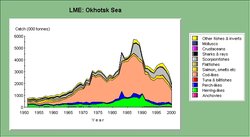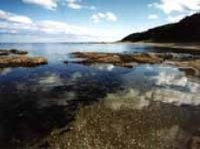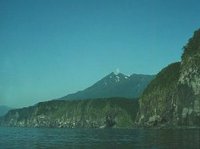Sea of Okhotsk large marine ecosystem
Contents
- 1 Introduction Location of the Sea of Okhotsk LME. (Source: NOAA (Sea of Okhotsk large marine ecosystem) )
- 2 Productivity
- 3 Fish and Fisheries
- 4 Pollution and Ecosystem Health
- 5 Socioeconomic Conditions
- 6 Governance
- 7 References
- 7.1 Articles and LME VolumesKuznetsov, V.V., V.P. Shuntov, and L.A. Borets, 1993. "Food Chains, Physical Dynamics, Perturbations, and Biomass Yields of the Sea of Okhotsk," in Kenneth Sherman, L. Alexander and B.D. Gold (eds.), Large Marine Ecosystems: Stress, Mitigation, and Sustainability (Washington, D.C.: American Association for the Advancement of Science, 1993) pp. 69-78. ISBN: 087168506X (Sea of Okhotsk large marine ecosystem)
- 7.2 Other References
- 7.3 Citation
Introduction Location of the Sea of Okhotsk LME. (Source: NOAA (Sea of Okhotsk large marine ecosystem) )
The Sea of Okhotsk Large Marine Ecosystem (LME) is a semi-enclosed sea at the edge of Russia and Northern Japan. Its average depth is 891 meters (m). Its maximum depth is 3,916 m (see Dubrovolsky and Zalogin, 1982). The sea is shallow in the north and deep in the south. There are marked differences in climate, hydrography, and biology in this LME. Variations in climate and hydrography relate to atmospheric (Atmosphere layers) processes over the northwest Pacific. Climate is the primary force driving the LME, with intensive fishing as the secondary driving force. LME book chapters and articles pertaining to this LME include Kuznetsov et al., 1993.
Productivity
For a map of surface circulation in the Sea of Okhotsk LME, see Kuznetsov et al, 1993, p. 70. For information on currents flowing into the Sea of Okhotsk from the Kurile Islands, see Davydov, 1984. The complex system of currents comprises three large cyclonic gyres (see Chernyavsky, 1981). For information on the geomorphology and hydrography of this LME, see Nishimura, 1985. There is considerable interannual variability. The variable climate and hydrography cause changes in reproduction conditions and trophic relationships. Surface temperatures range from -1.5 to -1.8 Celsius (oC) in the winter to 11 to 13oC in the summer. Below 30-75 m, the water temperature is persistently cold, with an approximate temperature of -1.7oC (see Kuznetsov et al., 1993). The Sea of Okhotsk LME is considered a Class I, highly productive (>300 grams of Carbon per square meter) per year) ecosystem based on SeaWiFS global primary productivity estimates. Plankton and benthic species are unevenly distributed throughout the LME as a result of complex circulation patterns. The most productive zones are in the upwelling areas. Waters off Kamchatka and in the North and West Sea of Okhotsk are especially abundant in plankton (see Markina and Chernyavsky, 1984). The deep area in the center has less plankton. For maps of average phytoplankton, zooplankton and benthos biomass, see Kuznetsov et al, 1993. For more information on the LME’s biotic structure, see Nishimura, 1985.
Fish and Fisheries
 Fish Catch Statistics from University of British Columbia Fisheries Center. (Source: NOAA)
Fish Catch Statistics from University of British Columbia Fisheries Center. (Source: NOAA) Species of commercial importance are walleye pollock, flounder, herring, Pacific salmon, cod and capelin (see Kuznetsov et al., 1993), and also halibut, Pacific sardine, Pacific saury, sand eel, smelts, crab and shrimp. The total average catch is 1.5 million tons. The walleye pollock (Theragra chalcogramma) has a biomass of 10-15 million tons and is the most abundant species, with a catch that exceeds the total catch of all the other fisheries. It is fished in the northern portion of the LME especially off West Kamchatka. Walleye pollock abundance appears to depend on climatic or oceanographic factors (warm and cold years).
Flounder (Pleuronectidae) is confined to shallow areas. Herring (Clupea pallasi pallasi) is harvested in the northeastern Sea of Okhotsk. Halibut is harvested along the continental slope. Overfishing affects most of the major fish stocks. The Global International Waters Assessment (GIWA) has issued a matrix that ranks LMEs according to the sustainable exploitation of fisheries and the predicted direction of future changes. GIWA characterizes the LME as severely impacted in terms of overfishing, with increasing impacts (see the GIWA web site). Intense exploitation began in the 1960s. Fluctuations in the catch are not fully understood, although climatic conditions appear to play an important role (see Kuznetsov et al., 1993). Stocks of Pacific salmon became depleted in the mid-1950s by a developing Japanese offshore fishery (Fisheries and aquaculture). Today, salmon stocks are low. There is a bycatch of grenadier, eel pout, skate and perch. The University of British Columbia Fisheries Center has detailed fish catch statistics for this LME. A graph of the data is provided below.
Pollution and Ecosystem Health
 (Source: NOAA)
(Source: NOAA) The Global International Waters Assessment (GIWA) has issued a matrix that ranks LMEs according to pollution, habitat modification and global change. GIWA characterizes the LME as moderately or slightly impacted in these areas (see the GIWA web site). A more severe impact is overexploitation of fisheries. Salmon stocks have decreased due to declining environmental conditions in the streams where they spawn (see Kuznetsov et al., 1993). In Kamchatka, Russia needs to protect its wild salmon resources for long-term sustainability. The exploitation of oil and natural gas recently discovered off Kamchatka's west coast and throughout the LME could affect marine and estuarine salmon habitats, disrupting food webs vital to salmon survival. A proposed pipeline and road could open presently pristine and inaccessible river systems to increased illegal salmon, steelhead and caviar fishing. There are threats of vessel collisions and net entanglements to the North Pacific right whale. The LME’s bowhead whale population is down to below 300 from an initial population of about 8,000. The waters off Sakhalin Island, an important breeding site for the spotted seal, are about to be opened up to massive oil and gas development. Tanker traffic and extreme weather conditions in the LME increase the risk of oil spills on the Northern Sea Route. In this event, the currents in the [[coast]al zone] of Sakhalin Island could propagate oil pollution all the way to the southern Kuriles and to the coast of Japan. In 1999, there was an oil spill at the Vityaz marine terminal, on Sakhalin Island. High levels of dissolved aliphatic hydrocarbons (DAH) and polycyclic aromatic hydrocarbons (PAH) are found on the northeastern Sakhalin Island Shelf. There are differences of opinion on the ecological consequences of oil spills and the influence of low concentrations of chronic oil pollution on aquatic organisms. Benthic and demersal species seem especially vulnerable.
Socioeconomic Conditions
 (Source: NOAA)
(Source: NOAA) Fisheries in the Sea of Okhotsk (crab, shrimp, pollock and other valuable seafood products) and fish processing provide an economic basis for the lucrative Sakhalin fishing industry as well as for fishing companies based in Kamchatka and in Japan. The regional economy depends on the export of these fishing products. However, overexploitation is depleting some of these fish stocks. The Kamchatka Peninsula (Russia) has a population of 500,000 people. There is potential for tourism in Kamchatka because of its landscape of active volcanoes and numerous populations of shorebirds and waterfowl. Oil and natural gas deposits were recently discovered off Kamchatka's west coast. The Peninsula is also rich in deposits of gold, silver, copper, and coal. But the remoteness of the area and its lack of infrastructure hinder regional development. The economy of Sakhalin Island is focusing on the recent discoveries of oil and natural gas in the area.
Governance
The LME comes under the governance of Russia. But the issue of who has sovereignty over the Kurile islands involves Japan. In the second half of the 1970s, the then Soviet Union introduced a fishery conservation and management zone (see Kuznetsov et al., 1993). A PICES (North Pacific Marine Science Organization) Workshop on the Sea of Okhotsk in 1995 provided a forum for the exchange of marine data. Japan after the 1999 oil spill off Sakhalin Island expressed concern about oil pollution issues. Various Japanese stakeholders urged the Japanese and Russian governments to be prepared in the eventuality of a spill. Russian authorities and international companies are perceived as being more interested in developing Sakhalin Island's oil and gas fields than in improving the island's capacity to prevent and respond to oil spills. Two environmental organizations (Sakhalin Environment Watch and the California-based Pacific Environment and Resources Center) invited a team of independent experts to the island in order to review local spill prevention and response measures. The investigation resulted in 78 detailed recommendations. While some of the recommendations, such as the one to conduct a comprehensive vessel traffic risk assessment of the Sakhalin coast, were implemented by Russian government agencies, there was still major international concern over this issue.
References
Articles and LME VolumesKuznetsov, V.V., V.P. Shuntov, and L.A. Borets, 1993. "Food Chains, Physical Dynamics, Perturbations, and Biomass Yields of the Sea of Okhotsk," in Kenneth Sherman, L. Alexander and B.D. Gold (eds.), Large Marine Ecosystems: Stress, Mitigation, and Sustainability (Washington, D.C.: American Association for the Advancement of Science, 1993) pp. 69-78. ISBN: 087168506X (Sea of Okhotsk large marine ecosystem)
Other References
- Chernyavsky, V.I. 1981. Circulation systems of the Sea of Okhotsk. Izv. TINRO 86:49-55. In Russian.
- Davydov, I. V. 1984. On correlation of development of oceanological conditions in main fishing grounds of the Far East Seas. Izv. TINRO 109. In Russian.
- Dobrovolsky, A.D., and B.S. Zalogin, 1982. Seas of the USSR. Published by MSU. 192 pp. In Russian.
- Elferink, Alex G. Oude, 1997. The Sea of Okhotsk Peanut Hole: De Facto Extension of Coastal State Control POLOS Report no. 2/1997. Lysaker, FNI, 1997. 25 p.
- Markina, N.P., and V.I. Chernyavsky, 1984. Some data on quantitative distribution of plankton and benthos in the Sea of Okhotsk. Izv. TINRO 109:94-99. In Russian.
- Nishimura, S. 1983. Okhotsk Sea, Japan Sea, East China Sea. In: Ecosystems of the World, Estuaries and closed seas, B.H. Ketchum, ed. 375-402.
| Disclaimer: This article is taken wholly from, or contains information that was originally published by, the National Oceanic and Atmospheric Administration (NOAA). Topic editors and authors for the Encyclopedia of Earth may have edited its content or added new information. The use of information from the National Oceanic and Atmospheric Administration (NOAA) should not be construed as support for or endorsement by that organization for any new information added by EoE personnel, or for any editing of the original content. |